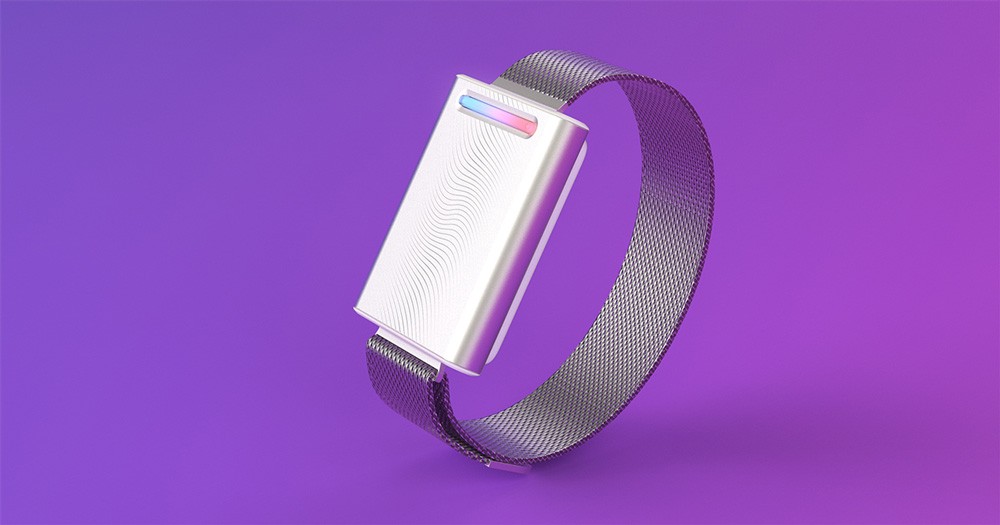Women suffering from hot flashes try to find relief in a device that wasn’t designed specifically for them.
If you talk to menopausal women about how they’re dealing with hot flashes, you hear the same story over and over again. After suffering one too many times from unpredictable overheating that makes it hard for them to work, read, exercise, garden, you name it, many women turn to hours of online research, hoping to find a non-hormonal solution. But their search comes up short.
Among their available options are special sleepwear made with moisture-wicking fabric, even though hot flashes can strike at any time of the day; gaudy “pearl” necklaces made of balls of cooling gel that they have to remember to store in the freezer; or a rechargeable handheld device called Menopod, which delivers a cooling sensation if they hold it against the back of their neck, disrupting whatever else they might be in the middle of doing.
Then came Embr Wave.
Estimating that as many as 70 million Americans — of all ages and genders — consider temperature an “everyday pain point,” a startup called Embr Labs recently began selling a $299 wristband designed to offer inconspicuous, personalized temperature control that won’t start an office thermostat war. The band, called Embr Wave, applies warmth or coolness to the underside of your wrist for three minutes at a time, tricking your brain into thinking the air temperature around you has changed without affecting anyone else in the room.
Even though Embr Wave wasn’t designed specifically with menopause in mind, women seeking relief from hot flashes have become some of the wristband’s most vocal advocates. So why aren’t there more tools at the disposal of women like them?
An off-label wearable
Menopause, which marks the end of a woman’s menstrual cycle, is brought on by a natural decrease in the production of estrogen and progesterone, usually between the ages of 45 and 55. The frequency of hot flashes varies greatly: they can come on a few times a week or many times a day, and for several hours at a time or only a few minutes.
What’s often underappreciated is how many years women must endure them. Some women begin having hot flashes even before menopause begins, during perimenopause, and end up experiencing them for 11 years or more. Hot flashes can also bring with them cognitive vagueness, perspiration, confusion, a red face and neck, increased heart rate, and tingling fingers. Keep in mind that women between the ages of 45 and 64 make up 18 percent of the workforce in the United States.
Currently, the most effective tool for dealing with hot flashes is hormone replacement therapy, but it’s neither foolproof nor risk-free. Some women still experience debilitating hot flashes even while on the medication, and others may choose to abstain altogether because of the major drawbacks, including increased risk of breast, uterine, and endometrial cancer.
For women like Robin Hofheinz, 55, the cooling feature on the Embr Wave wristband offers a non-hormonal respite. “Hot flashes cloud my ability to communicate,” says Hofheinz, who owns a retirement planning business and gives presentations to large groups for hours at a time. “It’s not like I can just go to the bathroom in the middle of my talk and put some cold water on my hands … [Embr Wave] has made all the difference in the world.”

Jackie Ross, 72, says that after just two of the band’s three-minute cooling cycles, she can feel the perspiration drying up on the back of her neck. “I have it on all the time, except when I sleep,” she says.
Inside the Embr Wave unit, which looks like a chunky Apple Watch, electrical current is directed through a semiconductor. If the current is made to flow away from the wrist, that generates a cold sensation; current flowing toward the wrist feels hot. The band’s single control button can also determine the intensity of the temperature that’s delivered.
This can mitigate hot flashes because everyone’s skin is covered in nerve cells called thermoreceptors that send messages to the brain about ambient temperature. Jolting even a few of these nerves with a cold sensation can fool the brain into thinking that the environment around your whole body is up to five degrees cooler than it actually is. The wrist is one of a few areas of the body that is particularly sensitive to temperature, along with the top of the head, back of the neck, and bottom of the feet.
Embr Labs was founded by a group of men at MIT who thought the device would help reduce energy consumption. Setting a building’s air conditioning to 75 degrees instead of 74 might not sound like much of a change, but that one-degree difference can, by some estimates, cut electricity bills by up to five percent. That one degree can also make a big difference in personal comfort, so Embr Labs envisioned its wristband as a sort of off-grid, last-mile delivery tool for temperature control.
The company can’t claim that Embr Wave is also a therapy for hot flashes, because it’s not a medical device approved by the Food and Drug Administration. Nonetheless, menopausal women are connecting the dots on their own. “If I’m wearing it and I hit cool, it’s like it stops [a hot flash] in its tracks. I no longer feel like I’m suffering. I no longer feel like I have no control,” says Sherri Orlofsky, 55.
But even if Embr Wave is a useful non-hormonal solution for some women, the device leaves a lot to be desired for many others — as you might expect from something that isn’t specifically optimized for menopause.
Olga Galvin, 55, said the battery on hers overheated so much that she returned Embr Wave after just three weeks. Because of the wristband’s design, the overheating battery would touch her skin if she bent her wrist to do anything, like text or fold laundry — the exact opposite of the sensation she wanted while having a hot flash. Galvin also felt that even when it wasn’t overheating, the band didn’t help her cool down anywhere but her wrist.
“In most cases, a problem has to be experienced in order to be understood.”
Meanwhile, Ross, who works on a computer all day, found that the band got in the way of typing. Hofheinz jokes that because the hardware is so bulky she feels the need to tell the audiences she addresses that what she’s wearing on her wrist isn’t a house arrest monitor.
Clearly, middle-aged women need something better than a device designed for some other purpose. It’s a reminder of how chronically under-served their market is.
We know nothing
Despite the fact that hot flashes affect up to 80 percent of menopausal women, the cause isn’t well understood—a problem that exists with many aspects of women’s health. That’s likely getting in the way of developing better therapies.
Harvard Medical School researchers hypothesize that hot flashes begin in the hypothalamus, which controls temperature regulation. But a 2013 study from Wayne State University found no significant activity in that part of the brain. The researchers put women in an MRI machine and documented spikes in the brain stem just before the beginning of a hot flash, and then in the insula and prefrontal cortex as the hot flash progressed.
What’s more, there’s almost no understanding of whether or how changing hormones are even involved in this response.
The most effective tool available for dealing with hot flashes is neither foolproof nor risk-free.
Part of what’s making this knowledge so elusive may be that Homo sapiens is one of the only species that experiences menopause. The only other two that we know of are killer whales and short-finned pilot whales; the jury’s still out on non-human primates. Animal models are the basis of so much of our understanding of human biology, so without a good one for menopause and its symptoms, there’s a lot more poking around in the dark.
Gender disparities in the technology and medical fields certainly aren’t helping generate solutions for this population. It’s something that even the most delighted Embr Wave users have been considering.
“Even though a lot of solutions have been driven by men who are compassionate to us and see the problem, the reality is, in most cases, a problem has to be experienced in order to be understood,” says Hofheinz. “It does become very disorienting to women when they begin to experience [menopause] because they feel a little crazy and the rest of the world doesn’t understand why they can’t get over it.”
















